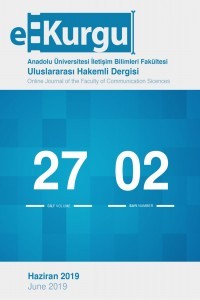ÇEvRİMİÇİ EGİTİMDE GÜDÜLEYİCİ ÖGRENME SİSTEMLERİNİN TASARIMI
Bir süreç olarak bakıldığında, öğretim tasarımı, belirli bir hedef kitlenin eğitim gereksinimlerinin saptanması ve bu gereksinimleri giderebilmek amacıyla işlevsel öğrenme sistemlerinin geliştirilmesidir. Nitekim, etkili öğrenme sistemlerinin geliştirilmesine yönelik çalışmaların sonucunda bazı öğretim tasarımı kuramları ortaya çıkmıştır. Bunlardan güdüsel tasarım kuramı, öğrenme güdusünü sürekli kılan bir öğretim tasarımı için öğretim süreçlerini öğrencilerin dikkatlerini, ilgilerint. güvenlerini ve doyumlarını artıran stratejilerle yapılandırmak gerektiğini belirtmektedir. Araştırmalar göstermektedir ki, söz konusu stratejilere dayalı olarak geliştirilen sistemler, öğretim sırasında öğrencinin dikkatini artırmakta, gereksinimleriyle ilişki kurmakta, başarı için olumlu beklenti yaratmakta ve başarının pekiştirilmesiyle doyum sağlamaya yardımcı olmaktadır. Bu çalışmada, bu konuyla ilgili yapılmış araştırmalar ve çevrimiçi eğitimde daha etkili güdüleyici öğretim tasarımları sunabilmek için öneriler özetlenmiştir.
Anahtar Kelimeler:
Güdusel tasarım kuramı, çevrimiçi eğtiim
MOTlVATlONAL DESIGN IN ONLINE EDUCATlON
Instructional design is concerned with identifying learning needs of a target group and developing alearning system toward accommodating these needs. Some instructional design theories discovered in the result of the studies which developing effective learning systems. The one which is ca/led motivational design theory indicates that the instructional processes have to contain strategies which enhance learner's attention, relevance, confidence and satisfaction in order to maintain learner's motivation in instructional design. Research shows that instructional systems developed based on these strategies enhance learners's attention, build relevance with their needs, help learners establish a positive expectancy for success and help learners establish a positive feelings about what has been accomplished during the learning. This paper summarizes results of current research on these matters, discusses implications of new developments, and offers recommendationsfor more effective motivational designfor the purpose ofonline education.
Keywords:
Motivational design theory, online education.,
___
- Bickford, N.L. (1989). The systematic application ofprinciples of motivation to the design of printed instructional materials (Unpublished doctoral dissertation). Florida State Univeristy, Tallahassee.
- Billings, D. (1989). A conceptual model of correspondence course completion. In M.G. Moore & G.C. Clark (Eds.), Readings in distance learning and instruction, 2. University Park, PA: ACSDE.
- Dick, W. & Reiser, R. (1989). Planning effective instruction. Englewood Cliffs, NJ: Prentice-Hall.
- Keller, J.M. (1979). Motivation and instructional design: A theoretical perspective. Journal ofInstructional Development, 2(4), 26 - 34.
- Keller, J.M. (1983). Motivational design of instruction. In C.M. Riegeluth (Ed.), Instructional design theories and models (pp. 383-434). Hillsdale, NJ: Lawrence Erlbaum.
- Keller, J.M. (1987a). Strategies for stimulating the motivation to leam. Performance & Instruction, 26(8), 1-7.
- Keller, J.M. (1987b). The systematic process of motivational design. Performance & Instruction, 26(9), 1-8.
- Keller, J.M. (1999). Motivation in cyber learning environments. International Journal ofEducational Technology, 1(1), 7-30.
- Keller, J.M. & Burkman, E. (1993). Motivation principles. In M. Fleming & W.H. Levie (Eds.), !nstructional message design: Principles from the behavioral and cognitive sciences (2nd ed.) (pp.3-53). Englewood Cliffs, NJ: Educational Technology Publications.
- Keller, J.M. & Kopp, T.W. (1987). An application of the ARCS model of motivational design. In C.M. Reigeluth (Ed.), !nstructional theories in actions: Lessons illustrating selected theories and models (pp. 289-320). Hillsdale, NJ: Lawrence Erlbaum.
- Keller, J.M. & Suzuki, K. (1988). Use of the ARCS motivational model in courseware design. In D.H. Jonassen (Ed.), !nstructional designs for microcomputer courseware (pp. 401-434). Hillsdale, NJ: Lawrence Erlbaum.
- Klein, J.D., & Keller, J.M. (1990). Influence of student ability, locus of control, and type of instructional control on performance and confidence. Journal of Educational Research, 83(3), 140-146.
- Lim, C.P. (2002). Trends in online learning and their implications for schools. Educational Technology, 4 (6), 43-48.
- Means, T.B., Jonassen, D.H. & Dwyer, F.M. (1997). Enhancing relevance: Embedded ARCS strategies vs. purpose. Edücational Technology Research and Development, 45( 1), 5-17.
- Moore, M.G. (1989). Three types ofinteraction. TheAmericanJournal ofDistance Education. 3(2), 1-6.
- Moore, M.G. & Kearsley, G. (1996). Distance education: A system view. Belmont, CA: Wadsworth.
- Naime-Diefenbach, B.N. (1991). Validation of attention and conjidence as independent components of the ARCS motivational model (Unpublished doctoral dissertation). Florida State Univeristy, Tallahassee.
- Newby, T. (1991). Classroom motivation: Strategies of three fifth-grade teachers. Journal ofEducational Psychology, 83(2), 195-200.
- Nwagbara, C.I. (1993). Effects ofthe relevance component ofthe ARCS model of motivational design (Unpublished doctoral dissertation). Purdue University.
- Scalese, E.R. (2001). What can a college distance education program do to increase persistence and decrease attrition? Journal of !nstruction Delivery Systems, 15(3), 16-20.
- Şimşek, A. (2000). Eğitim iletişimi. Eskişehir: Anadolu Üniversitesi İletişim Bilimleri Fakültesi (Yayın No:1251/39).
- Visser, L. (1998). The development of motivational communication in distance education support (Unpublished doctoral dissertation). The University of Twente, The Netherlands.
- Visser, L., Plomp, T., Amirault, RJ. & Kuiper, W. (2002). Motivating students at a distances: The case of an international audience. Educational Technology Research and Development, 50 (2), 94-110.
- Wlodkowski, R.J. (1999). Enhancing adult motivation to learn. (2nd ed.). San Francisco: Jossey-Bass.
- Wiggins, R.W. (1995). Growth of the internet. [On-line] Available at: http://www.themesh.com/gediti 2.html.
- ISSN: 1309-3487
- Başlangıç: 2014
- Yayıncı: Anadolu Üniversitesi
Sayıdaki Diğer Makaleler
İSTİHDAM EDİLEBİLİRLİK BECERİLERİ VE BUBECERİLERİN KAZANDIRILMASıNA YÖNELİK STRATEJİLER
KİTLENİN PSİKOLOJİSİ YA DA SOSYAL PSİKOLOJİNİN 'KİTLE'Sİ: KİTLEDE YENİ BİR ANLAYlŞA DOGRU
HABER YAPMA SÜRECİNDE HABER EDİTÖRÜVE EDİTORYAL SİSTEM
ULUSAL VE ULUSLARARASI BOYUTTA YAZlLl BASINDA KiŞİLİK HAKLARıNA SALDlRlDAN KORUNMA
BİRİ Bİzİ GÖZETLİvOR PROGRAMI VE ELEKTRONİK GÖZETİM
TELEVİZYON HABER-TARTIŞMA PROGRAMLARI VE GERİBİLDİRİMİN KATıLlMClLAR TARAFINDAN UYGULANMA BİÇİMLERİ
ORGANİZASYONEL ZEKANIN GELİŞMESİNDE ÖRGÜTSEL İLETİŞİMİN ROLÜ
HABERMAS'IN BURJUVA KAMUSAL ALANI TANıMı ÇERÇEVESiNDE YAZıLı BASıNıN KONUMU VE DÖNÜŞÜMÜ
